


Reaction between bromine/chlorine and red phosphorus
Bromine and red phosphorus react with each other with extreme violence. Finely powdered red phosphorus starts burning as soon as it comes in contact with bromine vapor. It is not even needed to have contact with the liquid, the vapor already ignites the red phosphorus. A white/yellow solid is formed in the reaction.
Chlorine gas has a similar effect on red phosphorus as bromine, but the effect is even stronger. Also fairly dilute chlorine/air mixtures may ignite the phosphorus already.

 This is a spectacular, but also quite dangerous
set of experiments. Be very careful and
never scale up the experiments for added effect! Also assure that the
fumes and smoke, produced in these reactions, are not breathed. These fumes and
smoke are intensely corrosive and very poisonous. These experiments MUST be
performed in a fume hood, or outside.
This is a spectacular, but also quite dangerous
set of experiments. Be very careful and
never scale up the experiments for added effect! Also assure that the
fumes and smoke, produced in these reactions, are not breathed. These fumes and
smoke are intensely corrosive and very poisonous. These experiments MUST be
performed in a fume hood, or outside.
The bromine experiment is similar to the experiment with aluminium and bromine. Large differences are that the color of the flames is quite different and that the reaction is immediate, there is no induction period.
![]()
![]() Required
chemicals for first experiment:
Required
chemicals for first experiment:
-
bromine
-
red phosphorus
![]() Required
chemicals for second experiment:
Required
chemicals for second experiment:
-
calcium hypochlorite
-
dilute hydrochloric acid
-
red phosphorus
![]() Required
equipment:
Required
equipment:
-
test tube
-
a safe way to attach the test tube firmly, do not hold it in your hand.
-
a dropper, needed for transferring the bromine from its container to the test tube
![]() Safety:
Safety:
-
 Bromine is very
toxic. The liquid causes deep and painful wounds, when it is spilled on the
skin. The vapor of bromine is very corrosive and highly toxic. The smell of
bromine is terrible.
Bromine is very
toxic. The liquid causes deep and painful wounds, when it is spilled on the
skin. The vapor of bromine is very corrosive and highly toxic. The smell of
bromine is terrible. -
 Chlorine, formed
in the reaction between calcium hypochlorite and hydrochloric acid also is
very toxic. Do not inhale the gas.
Chlorine, formed
in the reaction between calcium hypochlorite and hydrochloric acid also is
very toxic. Do not inhale the gas. -
 The reactions are very violent and a lot of corrosive and toxic fumes are produced. Assure
that the reactions are performed in a VERY well ventilated room, or outside.
The reactions are very violent and a lot of corrosive and toxic fumes are produced. Assure
that the reactions are performed in a VERY well ventilated room, or outside. -
Red phosphorus is flammable. It is not particularly toxic, nor corrosive.
![]() Disposal:
Disposal:
-
After the reaction, add some water. The final waste can be flushed down the drain with lots of water. The waste is not particularly toxic.
![]()


Adding red phosphorus to bromine
![]() Take a small drop of bromine (appr. 0.05 ml) and transfer
this to a test tube. The two pictures below show the small amount of bromine in the test tube.
Take a small drop of bromine (appr. 0.05 ml) and transfer
this to a test tube. The two pictures below show the small amount of bromine in the test tube.
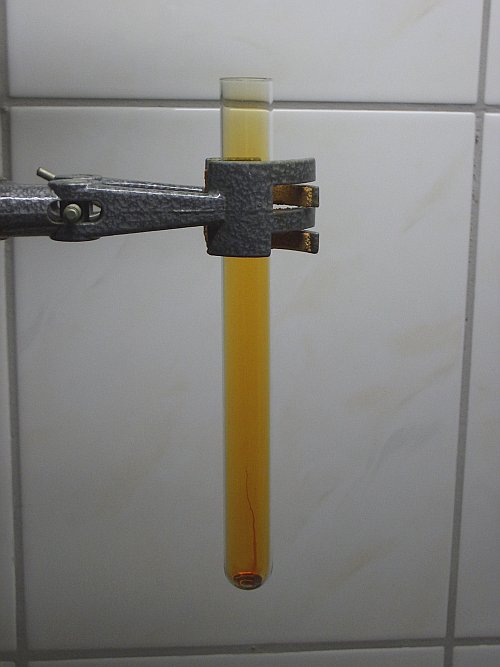
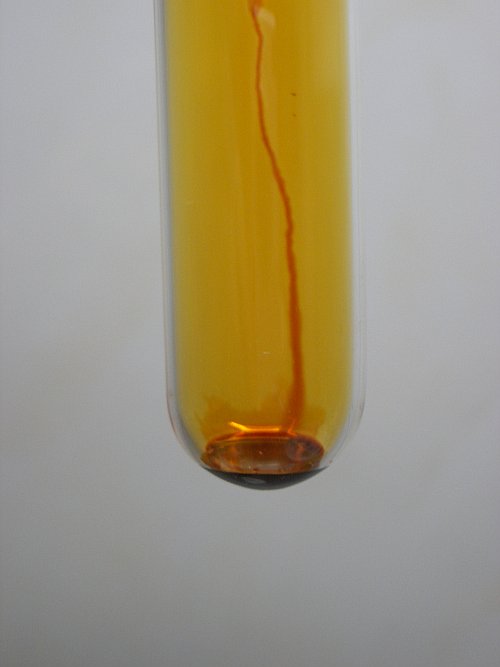
![]() Take no more than 10 mg of finely divided red phosphorus. This really is a tiny
amount, not more than a thin layer on the tip of a spatula with a width of a mm.
Carefully tap the spatula with the phosphorus into the test tube.
Take no more than 10 mg of finely divided red phosphorus. This really is a tiny
amount, not more than a thin layer on the tip of a spatula with a width of a mm.
Carefully tap the spatula with the phosphorus into the test tube.
The result is spectacular. Small pieces of phosphorus, falling in the test tube, ignite as soon as they enter the bromine vapor. A slightly larger piece of phosphorus (powder, sticking together) reaches the bottom, before it is completely burnt and keeps on burning with a bright flame at the bottom. The flames of the phosphorus are not as red as with the aluminium experiment, they are more greyish/white. Through the bromine vapor they look yellowish. The burning and motion of glowing specs of phosphorus through the test tube only lasts for a few seconds.
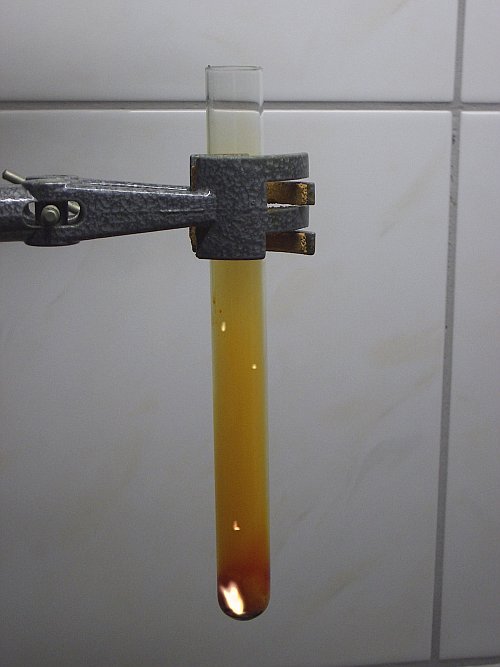
![]() When the flames of burning phosphorus have disappeared, then take a little more
phosphorus (not more than a few tens of mg) and tap this into the test tube.
When the flames of burning phosphorus have disappeared, then take a little more
phosphorus (not more than a few tens of mg) and tap this into the test tube.
When this is done, then no flames can be observed anymore. The bromine already has become more dilute. When the phosphorus reaches the bottom of the test tube, then it reacts with emission of white/yellow fumes. After the reaction, the test tube is filled with yellow smoke and at the bottom only a small amount of bromine is left. The picture below shows the formation of yellow fumes after adding more phosphorus.
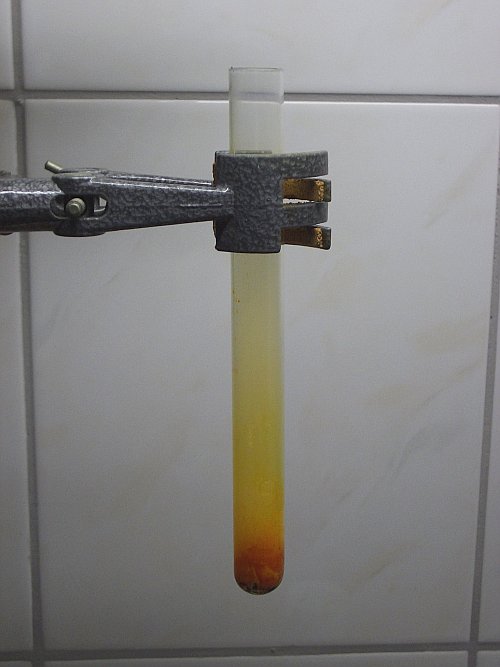
On cooling down, beautiful yellow crusts are deposited on the glass. A detailed picture is shown below. The dark matter at the bottom is unreacted red phosphorus, the yellow matter is phosphorus pentabromide, PBr5. The red 'wet' material at the bottom is PBr5 with remains of unreacted bromine. According to literature, PBr5 is lemon-yellow, which perfectly matches the observation.
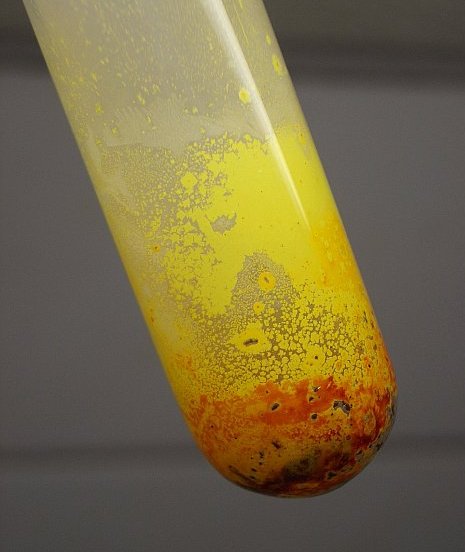
Hardly any fumes escape from the test tube in the reaction. All solids deposit on the glass.
![]() Add a few ml of cold water to the test tube.
Add a few ml of cold water to the test tube.
All yellow solid dissolves, the water becomes luke-warm and the solution becomes colorless, with particles of red phosphorus quickly settling at the bottom. Some additional checking with acidified potassium dichromate shows that the liquid is not reducing. This implies that all phosphorus is oxidized to its +5 oxidation state.
A video of the reaction between red phosphorus and bromine vapor was made as well. File size is just over 2.5 MByte. The resulting fume (mix of PBr5, Br2 and P4O10) is shown in another video, with a size of approximately 1.7 MByte.
![]()
Reaction between chlorine and red phosphorus
Chlorine and phosphorus react even more violently than bromine and phosphorus. As soon as phosphorus enters some chlorine gas, it burns with white flame. Also, when phosphorus comes into an air/chlorine mix, which only contains small amounts of chlorine, then it also inflames, but with an orange flame (burning mainly in oxygen).
The experiment can be performed as follows:
![]() Take a large spatula full of calcium hypochlorite
(approximately 65% active chlorine) and add approximately 5 ml of dilute
hydrochloric acid to this. This results in a large test tube, filled with
chlorine gas and a yellow/green liquid at the bottom of the test tube. The
result is shown below in the left picture.
Take a large spatula full of calcium hypochlorite
(approximately 65% active chlorine) and add approximately 5 ml of dilute
hydrochloric acid to this. This results in a large test tube, filled with
chlorine gas and a yellow/green liquid at the bottom of the test tube. The
result is shown below in the left picture.
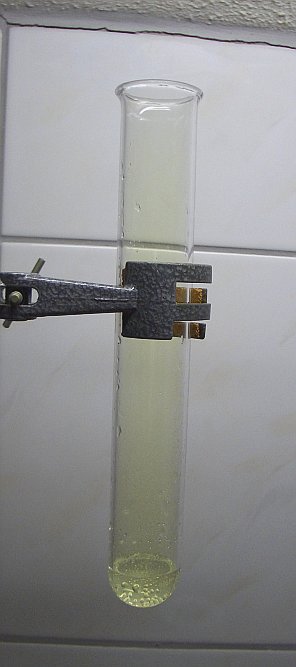
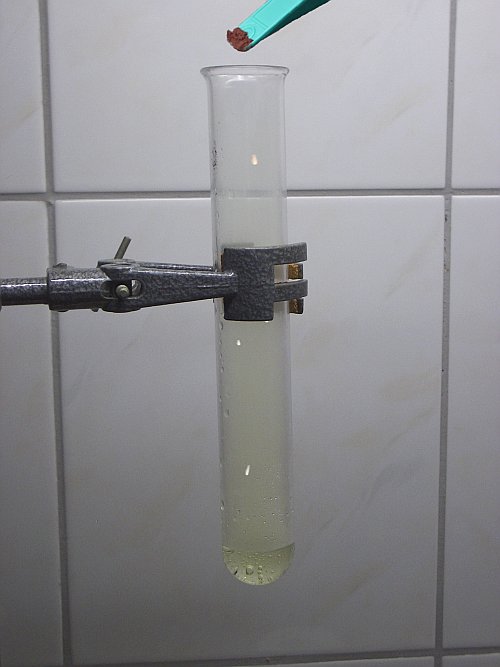
![]() The right picture shows what happens if some red
phosphorus is tapped carefully in the gas. Each little granule of red
phosphorus inflames at once, when it is falling down. When the phosphorus is
burning in the upper part of the test tube, then the flames are more orange, in
the lower part of the test tube, the flames are white.
The right picture shows what happens if some red
phosphorus is tapped carefully in the gas. Each little granule of red
phosphorus inflames at once, when it is falling down. When the phosphorus is
burning in the upper part of the test tube, then the flames are more orange, in
the lower part of the test tube, the flames are white.
![]() Beware, after generation of the chlorine gas, wait for a while, such that the
concentration of the gas at the higher part of the test tube has become somewhat
lower. In a first attempt of this experiment, the phosphorus on the spatula catched fire when it was kept near the open end of the test tube and the spatula
was ruined after that. Also, use small amounts of phosphorus and do not tap all
of the phosphorus into the test tube at once.
Beware, after generation of the chlorine gas, wait for a while, such that the
concentration of the gas at the higher part of the test tube has become somewhat
lower. In a first attempt of this experiment, the phosphorus on the spatula catched fire when it was kept near the open end of the test tube and the spatula
was ruined after that. Also, use small amounts of phosphorus and do not tap all
of the phosphorus into the test tube at once.
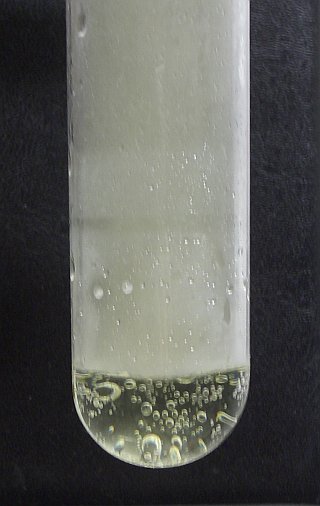
After all phosphorus had reacted with chlorine, a thick white fume was present in the test tube. This is best demonstrated by the picture below, where the test tube was kept in front of a dark object. The effect, however, also can be seen already at the right picture above. It is remarkable that no phosphorus is moving around in the liquid. Some phosphorus, reaching the liquid, also quickly was destroyed.
A video of the reaction between red phosphorus and chlorine was made as well. File size is just under 2.5 MByte.
![]()
Discussion of results
![]() Bromine and phosphorus react with each other, producing phosphorus pentabromide and a
lot of heat:
Bromine and phosphorus react with each other, producing phosphorus pentabromide and a
lot of heat:
2P + 5Br2 → 2PBr5
The compound PBr5 is volatile. On cooling down, is deposits on the glass in beautiful yellow patterns.
![]() When water is added, then the
PBr5
is hydrolysed at once:
When water is added, then the
PBr5
is hydrolysed at once:
PBr5 + 4H2O → 5HBr + H3PO4
In large excess amounts of water, the HBr and H3PO4 immediately are ionized as acids.
![]() With chlorine similar reactions occur. In the above
equations, Br can be replaced with Cl.
With chlorine similar reactions occur. In the above
equations, Br can be replaced with Cl.